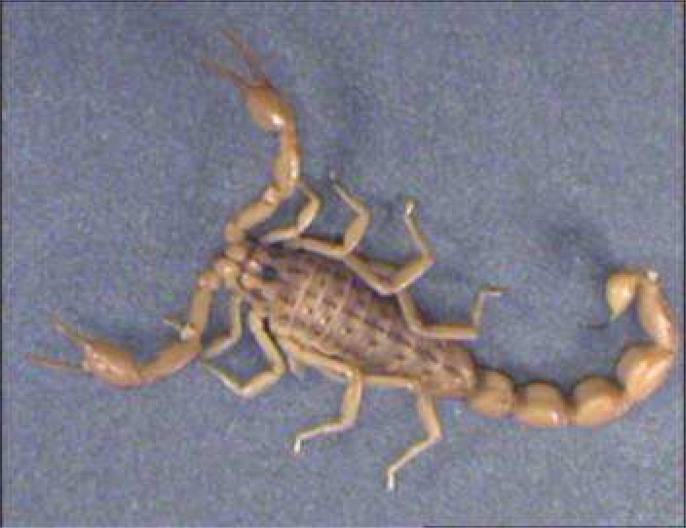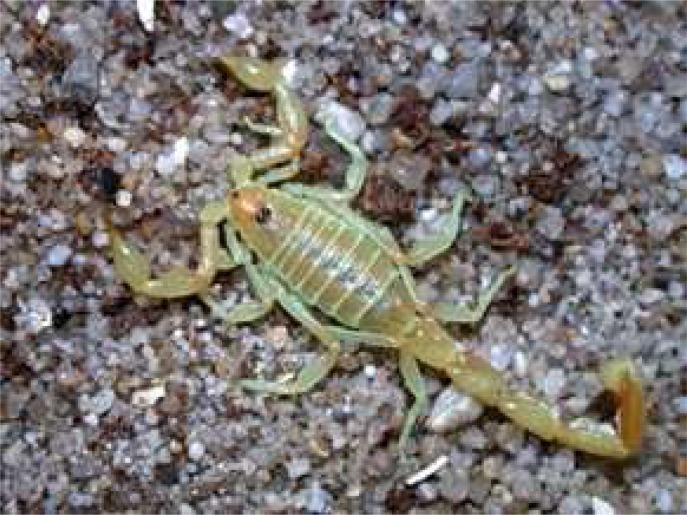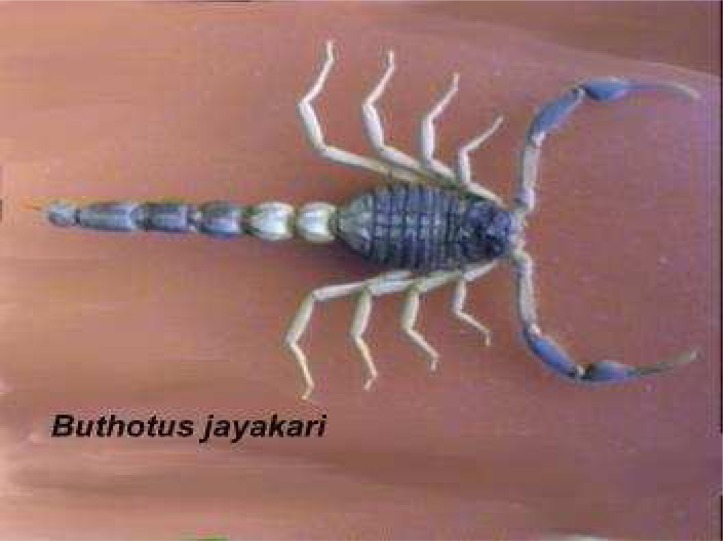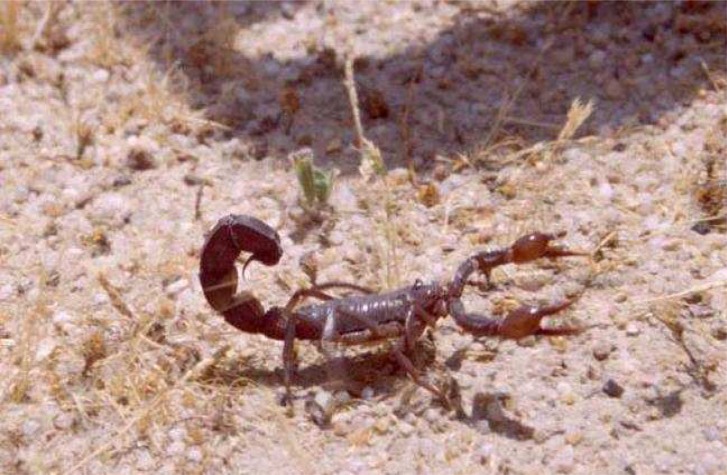Abstract
Background
Scorpions are known as the most widespread poisonous creatures that cause casualties and death to human. They are distributed in tropical and subtropical areas. Among the sixteen Iranian Island in the Persian Gulf, Qeshm Island is the biggest and is located in the focus of the important internal and international commercial marinelines. Furthermore, thousands of tourists also visit the Island every year for its natural beauties and the siteseeings. The present research study was carried out during 1998–99 throughout Qeshm Island in order to know the species of scorpions, their abundance, the distribution and control strategy in order to reduce the scorpion stings and to safeguard the visitors as well as the local population.
Methods:
Collections were made randomly during the night. Samples were searched by black light and then collected by forceps. A total of 102 scorpions were captured.
Results:
The scorpions were identified as Buthotus jayakari numbered 42 specimens (41.17%) and B. leptochelys numbering only 7 specimens (6.86%) belonging to the family Buthidae. Androctonus crassicauda was collected in the most parts of the Island and considered as the dominant species. The sex ratio was 1:1.53 in favor of females. B. leptochelys was rare species and by far restricted in its distribution.
Conclusion:
Considering the high population of A. crassicauda and its wide distribution, it is regarded to be responsible for the majority of scorpion stings in Qeshm Island.
Keywords: Scorpion, Fauna, distribution, Iran
Introduction
Scorpions are classified as arachnids. Fossils indicate that scorpions have originated in the sea and emerged on the land during the middle Silurian period, 425 to 450 million years ago. Scorpions have a wide geographic distribution, from tropical to temperate, including deserts, savannas, tropical forests, mountains over 5500 m in altitude, and the intertidal zone (Polis 1990).
Scorpions hide under stones, bark, wood or other objects on the ground where they wait or search for prey. Their foods comprise small insects, spiders, centipedes, earthworms, and other scorpions. Once they capture their prey, they use the large pincers to crush and draw it toward the mouth. The body juices of the prey are eaten by the scorpion. Scorpions are active at night and this behavior helps scorpions manage temperature and water balance, important functions for survival in dry habitats. Many species dig burrows in the soil. They detect and capture prey by the sense of touch.
They also have a well-developed sense of hearing. Some of these habitats, e.g. arid deserts, are of extreme environmental conditions, and scorpions have a range of adaptations for life in such harsh environments and they are most common and diverse (Jeram 1990).
Scorpions are nocturnal arthropods that have minimal surface activity and prefer to leave their burrows during periods surrounding the new moon (Warburg and Polis 1990). Totally, there are over 1500 species of scorpions worldwide which have been recorded although doubtless others await discovery. Of the 1500 species of scorpion only about 50 species were stated to have a sting which can be dangerous to humans (Mullen and Stockwell 2002, Ozkan and Karaer 2003).
Although scorpions has wide distribution in world but the majority distribute in altitude 23º to 38º (Kjellesvig-Waering 1986, Farzanpay 1988, Kovarik 1997) as well as Iran which is located in altitude 25 to 40 ºN and scorpions are highly active (Kamali 1984, Akbari 1996, Pouladgar 1999).
So far there is no any documented study about distribution of scorpions specious in Qeshm Island. Therefore, this investigation was carried out in the Island regarding to identify the species as well as their distribution. So based on the results of this study, a control strategy cab be planned to reduce scorpion stings.
Materials and Methods
Qeshm Island is the biggest island of the Persian Gulf and located in the Strait of Hormuz in the south coast of Iran and east of the Persian Gulf (26° 50′ N 56°0′ E). It has an area of over 1295 km2 and almost 100 kilometers long. Qeshm city is located in the northeast of the island. This island has hot and humid weather. The surface is mostly rocky and barren with a small human population.
Qeshm Island is also a free trade zone, which has made the island important to the regional trade. On what little cultivated land there is, dates and melons are grown. In order to determine the study areas the island divided to 20 regions and then 10 regions were selected by clustered random sampling. The flora of the studied areas was rich and the population density was high. In each studied area specimen collection was carried out.
The studied areas were Dargahan, Laft village, Gourzin, Tabl, Doulab, Basaeedoo port, Doostkoo, Namakdan, Salkh, Sibe deraz, Souza and Qeshm city (Table 1). The most scorpions are nocturnal, hiding under rocks, in crevices, or within burrows during the day, and coming out after sunset. The scorpion possesses a greenish glow. Unique to the scorpions is that the cuticle fluoresces under UV light, helping the nightly collection and observation of these interesting animals. Collections were made during the night searches using the black light (Russel 1968).
Table 1.
Prevalence of different species of scorpions collected from Qeshm Island, Iran
| Species | no | Prevalence (%) |
|---|---|---|
| Buthotus jayakari | 42 | 41.17 |
| Buthacus leptochelys | 7 | 6.86 |
| Hemiscorpius leptorus | 3 | 2.94 |
| Androctonus crassicauda | 35 | 34.31 |
| Mesobuthos eupeus | 15 | 14.70 |
| Total | 102 | 100 |
Diurnal study was carried out by searching under the stones, in piles of the rocks or masonry, in piles of the wood and under the trees’ barks. After collection, specimens were transferred in to the holding tubes including alcohol. For species identification several parameters including morphology, biology and ecology, date, place, habitats were considered. Identification was carried out by morphological characters according to the national standard taxonomic key identification (Farzanpey 1988). The data were analyzed, using Microsoft Excel.
Results
Scorpion’s fauna and Sex ratio in Qeshm Island
In this study, 102 scorpions were collected including Buthidae and two genera Buthidae Vachon, 1949 [Hottentotta Birula, 1908] and Buthacus Birula, 1908 including B. jayakari with 42 specimens (41.17%) (Simon, 1880), Buthacus leptochelys with 7 specimens (6.86%), Hemiscorpius leptorus with 3 specimens (2.94%) [Hemprich and Ehrenberg 1829], A. crassicauda with 35 specimens (34.31%) and Mesobuthos eupeus with 15 specimens (14.70%). B. jayakari is not a digger species. The average body length of adults is 13 cm. Telson, the 3 latest segment of tail, two movable and immovable fingers, prefemur of pedipalp, carapace, anterior margins of carapace and posterior part of mesosoma (apart from the latest segment of mesosoma) have blackish color. Other parts of the body are yellowish. The highest length of this scorpion among 42 collected specimens recorded as 11.8 cm. In males pectines had 36 to 39 teeth and in females pectines had 32 to 36 teeth (Fig. 1.).
Fig. 1.
Mesobuthos eupeus
Hemiscorpius. leptorus belongs to the family scorpionidae and is the county’s most dangerous scorpion. This scorpion is not digger species and found in bare areas. H. leptorus has sexual dimorphism. The average body length of adults is 5 cm and in males 7.5 cm. The color of the body varies from light yellow to the dark yellow. Legs and cheliceres are light, movable and immovable fingers are brown to red color. Brown patches are seen on the latest segment of the legs. A. crassicauda is not a digger species as well. The average body length of adults is 12 cm. Body’s color varies widely from brown, black to an olive color. Pectins, chelicera, end of legs and ventral surface of the body are light yellow (Fig. 2 and 3).
Fig. 2.
Buthacus leptochelys
Fig. 3.
Buthotus jayakari
Mesobuthos eupeus is not a digger species. The average body length of adults is 6 cm. The body’s color varies from yellow to a dark yellow. Dark and brown patches are seen on the dorsal surface of the body (Fig. 4).
Fig. 4.
Androctonus crassicauda
Buthacus leptochelys is also not a digger species. The average body length of adults is 7 cm. Color of dorsal surface varies from the yellow to a dark yellow. Carapace has no granule but according to its distribution it has smooth or disturbed granule carapace. Lateral eyes are small. The males have has30 to 32 pectinated teeth while the females have 25 to 27 teeth (Fig 4).
One hundred two specimens were captured from Qeshm Island. B. jayakari with 42 (41.17%) specimens was the most abundant in the studied area and H. lepturus with 3 specimens had the lower frequency. A. crassicauda had the same distribution in all over the island. Notes on the captured scorpions sex ratio on A. crassicauda, was 1:1.32 and show that females of A. crassicauda are more prevalent. The sex ratio was correlated to the population density of the adult males but the frequency of courtship attempts on females negatively correlated to the longevity of females. Higher population density of males limits the density of adult females (Hailey and Willemsen 2000). Three out of the 7 collected B. leptochelys were male and the rest were female.
This research was carried out in 13 regions of Qeshm Island. A. crassicauda had a uniform distribution in all parts of the island but B. leptochelys was only collected from Tablvi. And Dargahan and had less distribution in comparison to the B. jayakari. Ramkan and Souza with 93 (25.07%) scorpions collected had the highest frequency while the region from Parke Zaitoon to Simin Beach with 9 specimens (2.43%) showed the least frequency of scorpions. Most scorpions were catched in the regions with a rich flora. Only in one place that had poor vegetation flora the frequency of scorpions were high. The reason of this fact is that, there were much polluted and population density of insects that are the food of scorpions were high. There was not seen any scorpions in the coastal areas. The nearest collection point was 6 meters away from the coastal line (Salakh and Holor to Ramchah Area).
Disscussion
Qeshm island scorpion fauna is comprised of A.crassiauda and B. leptochelys, B. jayakari, H. leptorus, M. eupeus. A. crassiauda and B. leptochelys, which belong to the family Buthidae. These two species had the most prevalent among the collected specimens. This study showed that B. jayakari and A. crassiauda were more prevalent in the areas with rich flora of vegetation. B. jayakari has been recorded from Hormozgan (Hengam Island, Aboomousa, Tonbe-bozorg and Kish Island) and Fars Province (Polis 1990). Androctonus crassiauda has wide distribution in all parts of Iran from the northern to the southern provinces such as Khuzestan (Ahwaz, Omidiyeh, Bostan, Sousangerd, Mahshahr, Khoramshahr and Abadan), Semnan, Kerman, Kurdistan (Marivan), Boushehr, Ilam Province (Mehran, Ivan and Dehloran), West Azerbaijan (Chaldoran, Khoy, Makoo, Oshnoviyeh, Oroomiyeh), Kermanshah (Javanrood, Sarpolzahab, Qasr-e-Shirin) and Khorasan (Tibad, Khaf, Qaen, Birjand and Nehbandan) provinces (Russel 1968). Buthacus leptochelys is more prevalent in arid areas such as Khuzestan (Susa, Mahshahr, Sousangerd, Ramhormoz and Ahwaz), Hormozgan (Qeshm island), and Boushehr (Boushehr) provinces (Kjellesvig 1986).
Previous studies have shown that H. leptorus has wide distribution in Khuzestan (Ahwaz, Dezfoul, Izeh, Masjid-Soleiman, Ramhormoz and Susa), Semnan, Fars (the city of Shiraz), Kurdistan (Marivan), Hormozgan (the city of Bandar Abbas), Boushehr, Ilam (Mehran, Ivan and Dehloran), Lorestan (Poldokhtar and Aligoudarz) and Kermanshah (Javanrood, Sarpolzahab, Paveh, Qasr-e-Shirin) provinces (Russel 1968).
Mesobuthos eupeus has been recorded from Khuzestan (Susa, Mahshahr and Abadan), Kurdistan (Marivan, Saqqez, Baneh), Hormozgan (the city of Bandar Abbas), Golestan (Gorgan), Tehran (Varamin and Barghan mountains), Ilam (Mehran, Ivan and Dehloran), West Azerbaijan Province (Chaldoran, Khoy, Makoo, Oshnoviyeh, Oroomiyeh, Piranshahr and Sardasht), Kermanshah (Javanrood, Sarpol Zahab and Qasr-e-Shirin) and Khorasan (Tibad, Khaf, Qaen, Birjand and Nehbandan cities) provinces (Russel 1968).
These regions prepared the best thermal microclimate in comparison to the other parts of Qeshm Island. This condition attracts insects and the other arthropods which are the food source of the scorpions. Manmade modifications such as trash and debris have altered the situation for the benefit of the scorpions and careful inspection and cleaning-up of the polluted area needed to decrease their population. Presence of B. jayakari was also reported from the other neighboring islands such as Aboomousa and Kish (Khaghani 2005) but in the mainland this species was just once reported in some southern cities (Akbari 1996). Regarding the high prevalence of B. jayakari in Qeshm Island, it is concluded that this island offers the best ecological condition for the activity of this species. In agricultural landscapes, the dominant vegetation associations will generally provide a useful basis for the activity of scorpions. These associations tend to have dominant species and characteristic structural attributes. These associations also tend to correlate with the soil type and the other land features.
Control of scorpions using different method such as remove all trash, logs, boards, stones, bricks and other objects from around the home, keep grass closely mowed near the home, prune bushes and overhanging tree branches away from the house, tree branches can provide a path to the roof for scorpions is necessary specially in villages.
Acknowledgments
The authors would like to appreciate Mr. Mohammad Mohebi, Eng. Maad Moshtaghi (Sama University), Eng. Hosseini and Eng. Jabarzadeh, tutors of the Qeshm University for their helpful comments, friendly collaboration, helping us on the scorpion taxonomy and providing the assistance to carry out the current research. This research was in part supported by a Tarbiat Modarres Research grant to the senior author. The authors declare that they have no conflicts of interest.
References
- Akbari A. Study on geographical distribution of scorpions in south parts of Iran. Pazhohesh va sazandegi. 1996;34:115–112. [in Persian]. [Google Scholar]
- Jeram Andrew J. Book-lungs in a Lower Carboniferous scorpion. Nature. 1990;343:360–361. [Google Scholar]
- Farzanpay R. A catalogue of the scorpion occuring in Iran, up to january 1986. Revue Arachnologique. 1988;8(2):33–44. [Google Scholar]
- Hailey A, Willemsen RE. Population density and adult sex ratio of the tortoise Testudo hermanni in Greece: evidence for intrinsic population regulation. Journal of Zoology. 2000;251:325–338. [Google Scholar]
- Kamali K. An introduction to Khuzestan important scorpions. Agriculture Science Journal. 1984. p. 35. Faculty of agriculture press, Chamran University. [in Persian].
- Kaghani R, Tirgari S, Omrani Gh, Rafinejad J, Mousavi E. Faunestic study and distribution of scorpions in Kish Island, Iran (Persian Gulf) Modares Journal of Medical Sciences. 2005;8(1):7–12. [in Persian]. [Google Scholar]
- Kjellesvig-Waering EN. A restudy of the fossil scorpion of the world. Ithaca, N. Y.: Paleontological Research Institute; 1986. Paleontographica Americana; on. 55. [Google Scholar]
- Kovarik F. Results of the Czech Biological Expedition to Iran. Part 2, Arachnida: scorpiones, with description of Iranobuthus krali gen.n. et sp.n. and Hottentotta zagrosensis sp.n. (Buthidae) Acta Soc Zool Bohem. 1997;61:39–52. [Google Scholar]
- Mullen G, Stockwell SA. Medical and veterinary entomology. Academic Press; Amsterdam: 2002. [Google Scholar]
- Ozkan O, Karaer Z. The scorpions in Turkey Turk Hig. Deney Biyol Derg. 2003;60:55–62. [Google Scholar]
- Pouladgar A. Study on the prevalence of different species of scorpions in Khuzistan province. Pazhohesh va sazandegi. 1999;40:175–177. [in Persian]. [Google Scholar]
- Polis GA. The Biology of Scorpion. Stanford University Press; Stanford, California: 1990. [Google Scholar]
- Russel FE. Scorpion Collecting. Toxicon. 1968;6:307–308. doi: 10.1016/0041-0101(69)90103-2. [DOI] [PubMed] [Google Scholar]
- Warburg MR, Polis GA. Behavioral responses, rhythms, and activity patterns. In: Polised GA, editor. The Biology of Scorpions. Stanford University Press; Stanford, California: 1990. pp. 224–246. [Google Scholar]






